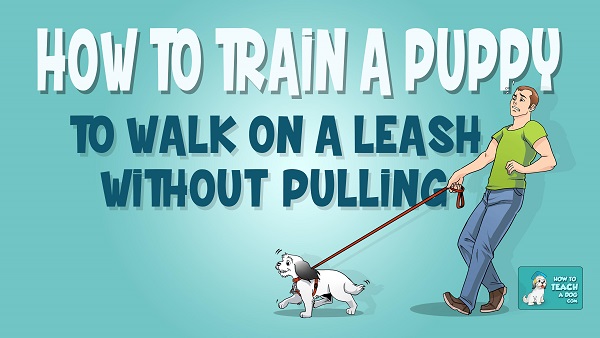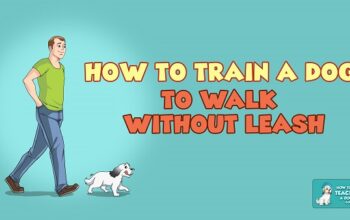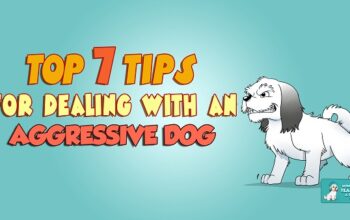
Let’s face it, dogs aren’t born with leash manners. If your dog is pulling on the leash, you’ll need to provide some guidance and training otherwise your dog will pull more and more. If you just got a puppy or a new dog, it’s a good idea to start training polite leash walking from day one. If your dog instead has been pulling on the leash for some time, you’ll have to put more effort to eradicate a habit that has been allowed to put roots over time.
Luckily though, with patience, the right techniques and the aid of some soft, tasty treats, you’ll soon be on your way to calmer, less frustrating leash walks. In this article, you’ll get some tips on how to train a puppy to walk on a leash without pulling. Just make sure to start training in quiet areas at first. Once your dog gets better, you can then gradually incorporate distractions.
1 – Stop Reinforcing the Pulling
Your very first step is to stop getting yanked and dragged around. Every time you allow your dog to pull you around, you’re reinforcing the pulling behavior. Dogs perform behaviors that are reinforcing and reinforcement keeps behaviors alive. If your dog wants to go sniff a bush or meet another dog and he pulls you to gain access to them, his pulling gets rewarded because he gets to do what he likes.
Even just a slight step forward or your hand or arm extending forward a few inches will reinforce pulling. Consider that any little progress that gets your dog closer to the object of interest will make pulling worth it. This is why retractable leashes encourage pulling. Every time the dog pulls, more line unrolls, ultimately rewarding the dog’s pulling action. On top of that, consider that dogs have an opposition reflex, that is, a natural resistance to pressure.
If every time your dog pulls, you pull back with your leash trying to stop him, he’ll pull even more, so pay close attention to what you do when your dog pulls. Are you moving forward? Are you extending your hand or arm? Are you pulling back? You may not be aware of these things you do until you become conscious of them.
2 – Invest in a No Pull Dog Harness
Stopping your dog from dragging you around is much more easy if you use the right tools. If your dog is large and strong, you may want to consider using a no pull dog harness also known as a front-attaching harness because the leash attaches to a front ring by the dog’s chest. Because this type of harness controls the dog’s torso, you’ll have more control and you can finally say goodbye to all those choking and gagging sounds associated with neck collars.
And if you own a small dog, you may still want to stick with a no-pull harness since many small dogs like the Yorkie, Chihuahua and Pomeranian are prone to collapsed trachea, a condition made worse by the pressure of the collar against the trachea.
3 – Follow the Rules
Once you understand how being dragged around and pulling back with your leash encourages pulling, it’s time to follow some simple rules. You want to make it clear to your dog that you’ll stop when he starts pulling and walk when the leash is slack. Think of a loose leash as your accelerator and a tight leash as your breaks. The moment your dog starts walking fast and the leash starts losing its slack, start slowing down and come to a complete halt once the leash gets tense.
Make sure you are very consistent in this as dogs thrive on consistency. If you follow these rules carefully on morning walks, but then, when you take your dog to the dog park you allow him to drag you there, you aren’t being consistent. This just teaches your dog that pulling is worth because it sometimes pays off.
4 – Train to Stick Nearby
At some point, once your dog starts noticing that his pulling is no longer working in getting him from point A to point B, he’ll start looking at you, almost as if asking ‘‘now what?” This is a good time to train your dog what to do. Once you have stopped and your dog is in front of you, say the word ‘‘heel” and show your dog a treat to lure him next to you.
You will need to make a semi-circle movement with your hand to get your dog to face your same direction, parallel to you. Once your dog is next to you in heel position, praise him, reward him with the treat and start walking. Repeat this several times.
Don’t worry, you won’t always have to show your dog a treat to get him to come next to you. It’s important to stop showing the treat at some point otherwise you‘ll risk bribing your dog and he won’t heel unless he sees the treat. Once your dog understands the meaning of the word heel, hide the treat in one hand or in a pocket, and give it after your dog comes next to you in heel position. Remember to pop a treat in your dog’s mouth every now and then even when he walks next to you. You want to make your side a wonderful place to be, a sweet spot if you will.
As training progresses, treats can also be faded overtime, you can give them every now and then or you can use them to reward exceptional performances, while other times you can simply use praise. Don’t forget the fact that after stopping, resuming walking once your dog is next to you, is also a big reward as dogs love to keep moving!
Training your dog to walk nicely on leash will take some time, but if you’re consistent it’s a lifelong investment that will make your walks much more pleasurable. Training your dog to walk on a leash though doesn’t mean your dog loses the privilege of doing all things he loves. Instead, find a compromise. Your dog can go sniff a bush or go say hello to a neighbor as long as the leash is slack. This ultimately offers a win-win situation for all. Happy walking!


